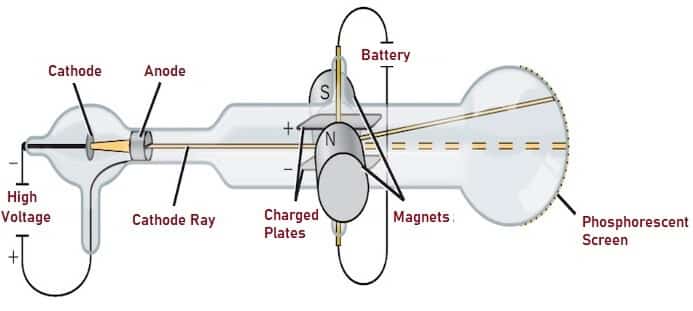

The velocity in the Y direction is constant, and the displacement in the Y direction is given as The initial velocity of the electron enters into the deflection plate is equal to zero, and the equation gives the displacement of an electron in the Y direction at any time t The term ay shows the acceleration of electrons in the y direction. The force acting on the electron in the Y direction. The equation gives the electric field intensity in the Y direction The velocity of the electron in X direction remains same throughout the deflection plate because no force was acting in the X direction. And their energy is given by the equationĮquating the potential and kinetic energy we get the velocity of the electron when it enters in the deflecting plates. The formula gives the potential energy of the electron. When the electron moves from the accelerating cathode to anode, they lose their potential energy. L = Distance between screen and the mid of the deflecting plates.ĭ = deflection of the electron beam on the screen in the Y direction. L d = length of deflecting plate in meters. V OX = velocity of the electron when entering into the deflecting plates in meter per second.Į d = potential between deflecting plates in Volts.ĭ = distance between deflecting plate in the meter. Hence, no acceleration of electrons occurs in that direction.Į 0 = Voltage of pre-accelerating anode in volt. There is no force either in X direction or the Z direction. The electron enters between the plates experienced the force only in the Y direction, and the electron will move only in that direction. These deflection plates produce the uniform electrostatic field in the Y direction. The A and B are the two parallel plates between which the potential difference is applied. The general arrangement of the electrostatic deflection is shown in the figure below. These plates allow the beam to pass through the deflecting plates without striking them. The other pair is mounted horizontally and generates an electric field in the vertical plane and causes vertical deflection. The vertical plate produces an electrical field in the horizontal plane and causes horizontal deflection. The CRT uses vertical and horizontal plates for focussing the electron beam. The electrons after exiting through the electron gun pass through deflecting plates. If we alter the potential difference between the Y-plates, the beam is deflected upwards or downwards on the screen.The cathode ray tube uses deflecting plates for modifying the path of electrons. Usually, the potential difference applied to the X-plates makes the spot move across the screen at a uniform speed. This deflection is produced by two pairs of parallel plates arranged at right angles. If necessary the stream of emerging electrons can be deflected in its passage between the gun and the screen. On leaving the gun, the electron stream passes across the tube and eventually hits the screen at the far side. Such arrangement of electrodes where a stream of electrons is produced is often known as the electron gun. As a result, the electrons accelerate across the gap between the electrodes and a narrow stream of the electrons emerges from the hole in the anode.

A potential difference of some hundreds of volts is applied between cathode and anode.

At a short distance from the cathode is an anode having a central hole in it. In the oscilloscope, the electrons are emitted by a hot cathode which is situated in a highly evacuated tube. The oscilloscope has many points in common with the discharge tube. The glow produced by the fast moving electrons on a fluorescent screen led to its use in radar and television. The discovery of cathode rays led to a vast field of practical application in Electronics. Modern cathode ray tubes have hot cathodes which require much less voltage, nearly 3000 volts. It needed a high voltage of the order of 30,000 volts. The cathode, in the discharge tubes used by Sir Thomson, was cold cathode. Experiments showed that mass of the electron is approximately 1/1860 of mass of hydrogen atom. Thomson found that the electrons had mass far less than of even the hydrogen atom. We know that hydrogen atom is the lightest atom. As these emanate from the cathode, the rays are called the Cathode Rays. These electrons emanate normally from the cathode. When this fluorescence was investigated, it was found that the fluorescence consisted of beams of negatively charged electrons. When the pressure in the discharge tube is less than 10 -4 mm of Hg, the discharge tube starts showing fluorescence.


 0 kommentar(er)
0 kommentar(er)
